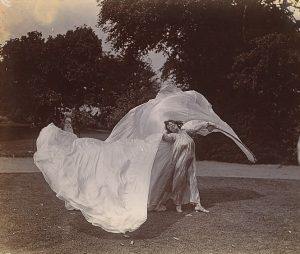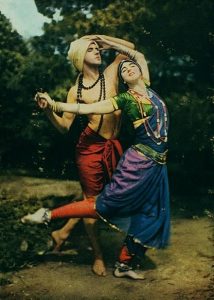Modern dance appeared in Germany and the United States in the early 20th century. In the late 19th century, the second Industrial Revolution brought significant changes. The rise of people who lived and worked in cities, mainly middle-class or white-collar workers, lived less active lifestyles resulting in the task of public health officials to prevent the spread of diseases caused by sedentary lifestyles. Emphasis on the benefits of maintaining a regular exercise regimen, such as dance, gymnastics, and sports, was highly praised. European theorists Delsarte and Dalcroze introduced methods for understanding human movement that was presented to colleges as “aesthetic dance.” These theorists made an impression on emerging modern dancers as they provided new ways to uncover the expressive qualities of the body by responding to internal sensations with greater freedom in movement possibilities.

Loie Fuller was a former actress and skirt dancer, a popular dance form in Europe and America, mainly found in burlesque and vaudeville. Fuller is known for her dramatic manipulation of fabrics and lighting designs, creating visual effects such as butterfly wings and fire images. She made these effects by shining light onto her voluminous silk costumes. Loie also experimented with electrical lighting, colored gels, and projections.
Watch This
Fuller debut as a dancer in Serpentine Dance.
Isadora Duncan rejected her early training in ballet technique feeling the movement and costumes were restrictive and lacked personal expression. Instead, she explored more natural movements, such as walking, running, skipping, and jumping. Instead of ballet attire, she emulated the Greeks when she wore tunics, danced barefoot, and performed dances about nature. It gave her movement a sense of freedom and abandonment.
Historically, modern dance has been tied to cultural forces that reflect society. Duncan’s dances expressed the human condition, especially women’s rights. She traveled throughout America and eventually settled in Europe, where she founded her school. Duncan trained dancers and called them “Isadorables.”
Watch This
Duncan perform outdoors.
Ruth St. Denis became fascinated with cultures worldwide when she saw an advertisement for Egyptian Deities cigarettes. The image of the goddess on the cigarettes inspired her dances honoring goddesses and deities based on her impressions of Indian, Egyptian, Spanish, and Javanese dance forms that weren’t culturally accurate. Instead, they were a reflection of her aesthetics.
Watch This
Denis’ East Indian Nautch Dance inspired by the dance practiced by the nautch girls of India.

Ruth St. Denis married Ted Shawn; this also began a creative partnership. Together they founded the Denishawn School, creating a diverse curriculum that included ballet, Asian dances, and dance history. They encouraged dancers to connect their dancing body to their mind and spirit. Through their school emerged the first generation of modern dancers.
Ruth St. Denis and Ted Shawn parted ways. St. Denis turned her attention to religion and continued teaching South Asian dance forms. Ted Shawn went on to found Jacob’s Pillow in Massachusetts, the nation’s oldest dance festival.
Ted Shawn formed an all-male dance company called Ted Shawn and His Men Dancers, hoping to make modern dance a respected profession for male dancers.
Watch This
Kinetic Molpai is a dance work in 12 parts; it features Ted’s all-male company who form a chorus. A solitary man, the leader, joins them sporadically. Fun fact: Shawn recruited athletes from Springfield College that had no experience in dance and trained them.